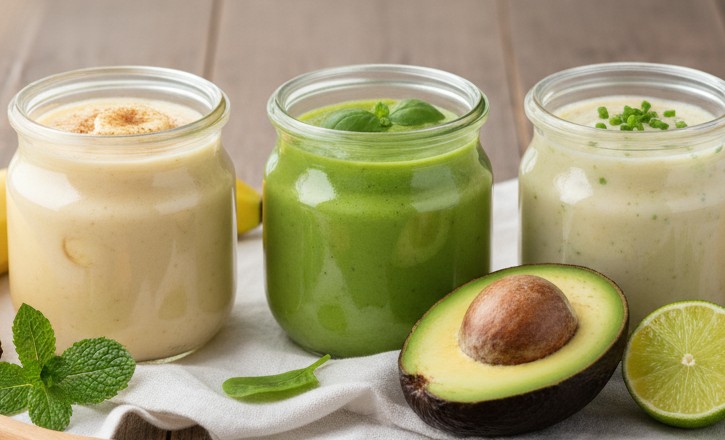
Congratulations, you’ve reached a new and exciting milestone! Your baby is now between 6 and 8 months old, which means it’s time to introduce solid foods. This period is a crucial time for growth and development, and offering a variety of healthy, nutrient-rich foods is key. While formula or breast milk remains the main source of nutrition, starting solids helps your baby develop new tastes, textures, and eating skills. Making your own baby food at home is a great way to ensure your little one is getting the best, most wholesome ingredients without any added salt or sugar.
Getting Started: The First Steps
Before you dive into recipes, it’s important to remember a few basics. Always consult with your pediatrician before starting solids. When you’re ready, begin with single-ingredient purees to see how your baby reacts. Wait a few days between introducing new foods to watch for any allergies. As your baby gets more comfortable with solids, you can start combining ingredients and even introduce mashed or finely chopped foods to help them learn to chew.
Here are three simple, healthy, and delicious recipes to get you started.
Recipe 1: Simple Sweet Potato Puree
Sweet potatoes are a fantastic first food. They’re naturally sweet, full of vitamins, and easy to digest.
Ingredients:
- 1 medium sweet potato
Instructions:
- Preheat your oven to 400°F (200°C).
- Wash the sweet potato thoroughly. You can leave the skin on for roasting to lock in nutrients.
- Place the sweet potato on a baking sheet and bake for 45-60 minutes, or until it’s soft when you poke it with a fork.
- Once cool enough to handle, scoop the soft flesh out of the skin and place it in a blender or food processor.
- Puree until smooth. If needed, add a little breast milk, formula, or water to get the desired consistency.
Recipe 2: Avocado and Banana Mash
This no-cook recipe is perfect for a quick and creamy snack. Avocado provides healthy fats, and banana adds natural sweetness and potassium.
Ingredients:
- 1/2 ripe avocado
- 1/2 ripe banana
Instructions:
- Peel and chop the avocado and banana.
- Place both into a small bowl.
- Mash with a fork until you reach a smooth, creamy texture. You can also use a blender for an extra-smooth puree.
Recipe 3: Pear and Pea Puree
A great combination that introduces your baby to a savory flavor with a touch of fruit sweetness. Pears are gentle on the tummy, and peas are packed with vitamins.
Ingredients:
- 1 ripe pear, peeled and cored
- 1/2 cup fresh or frozen peas
Instructions:
- If using fresh peas, cook them by steaming or boiling until tender. If using frozen, simply steam them.
- While the peas are cooking, chop the pear into chunks.
- Place the cooked peas and pear chunks in a blender or food processor.
- Puree until smooth. Add a little water if it’s too thick.
Conclusion
Introducing your baby to solid foods is an exciting adventure. By preparing these simple and healthy recipes at home, you’re giving your little one a great start to a lifetime of healthy eating. Remember to have fun with it, be patient, and celebrate every new bite.
What other combinations are you excited to try for your baby?
FAQ
Q: How do I know when my baby is ready for solid foods?
A: Your baby is likely ready if they can sit up with support, have good head control, show interest in what you’re eating, and have lost their tongue-thrust reflex (the reflex that causes them to push food out of their mouth).
Q: How much food should I give my baby at a time?
A: Start with just 1-2 teaspoons once a day. You can gradually increase the amount and frequency as your baby gets used to it. Follow your baby’s cues—if they turn their head away or seem disinterested, don’t force it.
Q: Can I store homemade baby food?
A: Yes! You can store purees in an airtight container in the refrigerator for up to 3 days. For longer storage, freeze them in ice cube trays. Once frozen, you can transfer the cubes to a freezer bag and store for up to 3 months. Thaw a cube or two in the refrigerator or microwave when you’re ready to serve.
Q: What about food allergies?
A: Introduce new foods one at a time and wait 3-5 days before introducing another new food. This makes it easier to identify any potential allergic reactions, such as a rash, swelling, or digestive issues. If you notice any signs of an allergy, stop feeding that food and contact your pediatrician.
Q: Should I add salt or sugar to the baby food?
A: No. Babies’ kidneys are not fully developed to process high amounts of salt, and sugar can lead to unhealthy eating habits later on. The natural sweetness of fruits and vegetables is all they need.